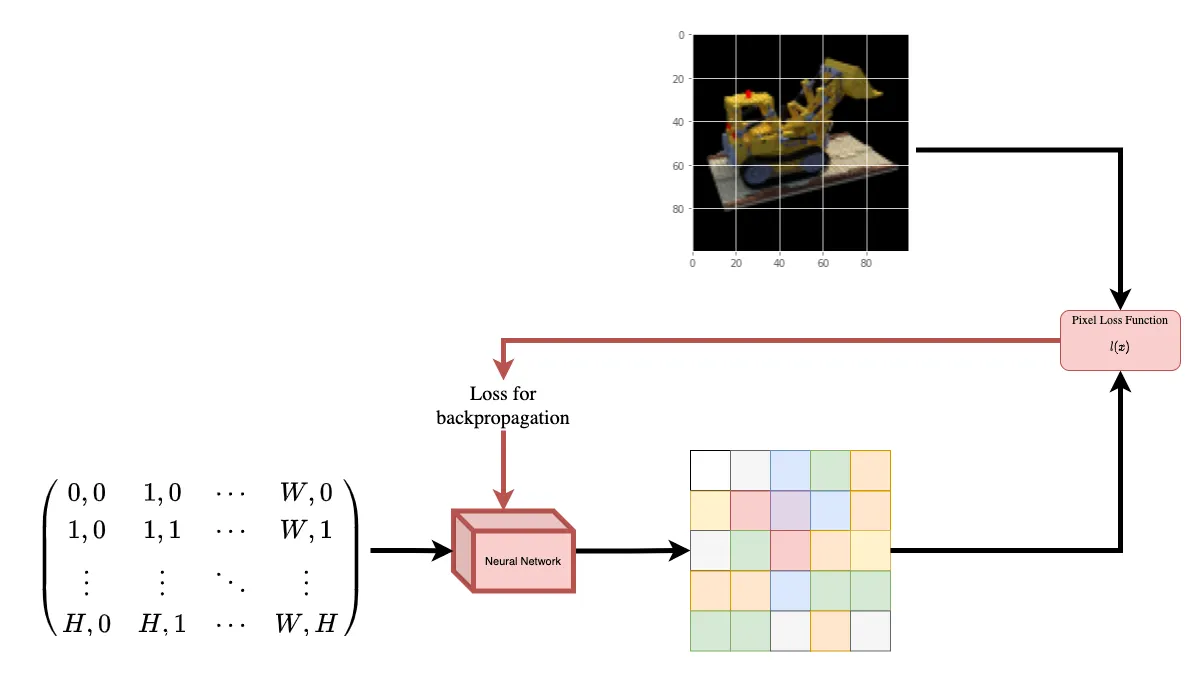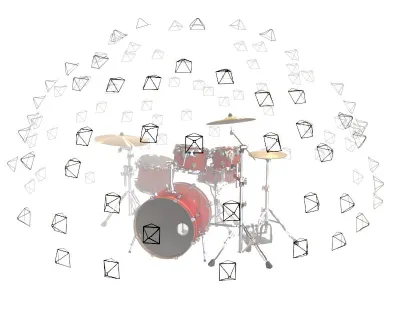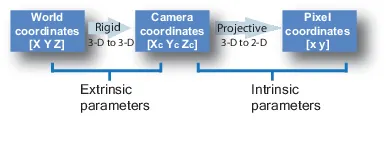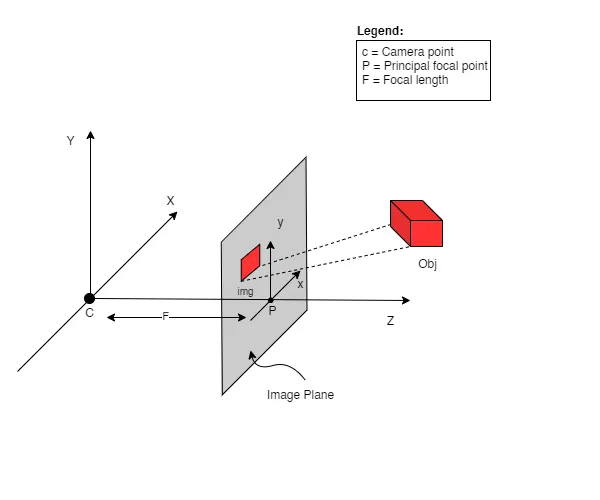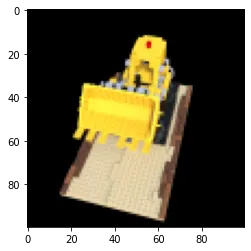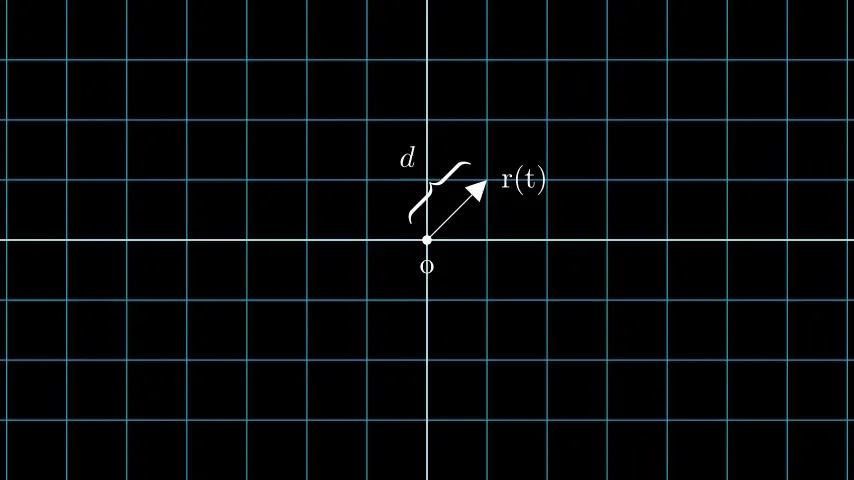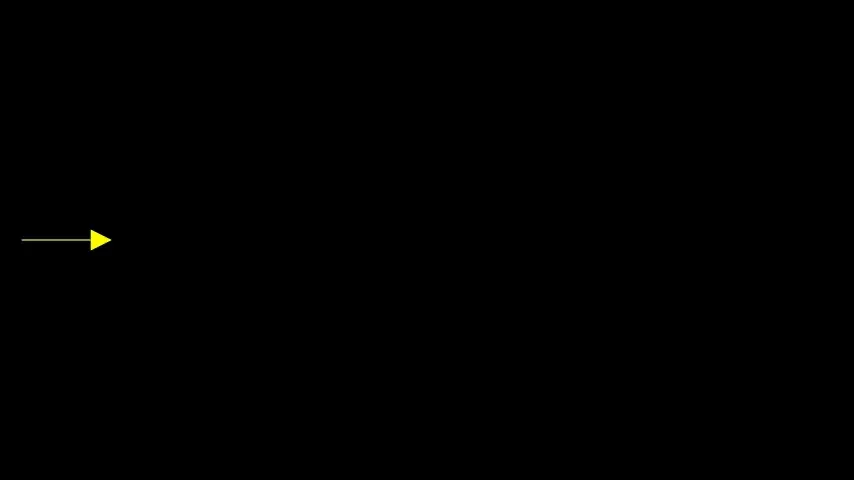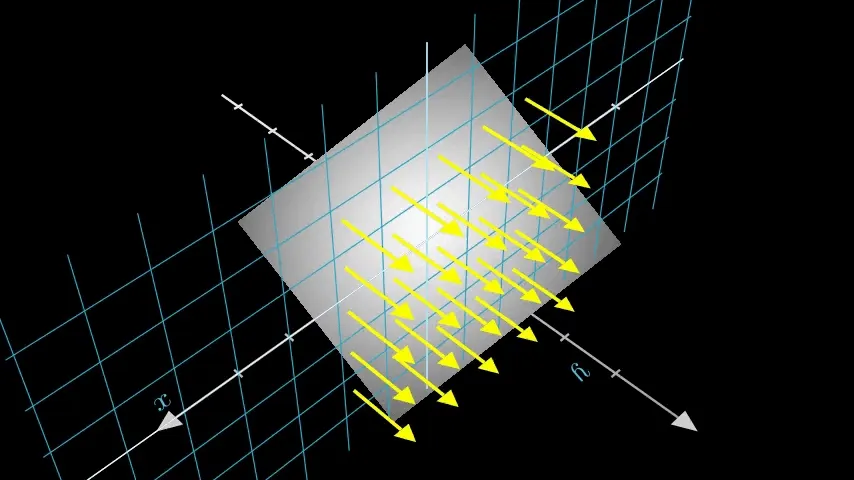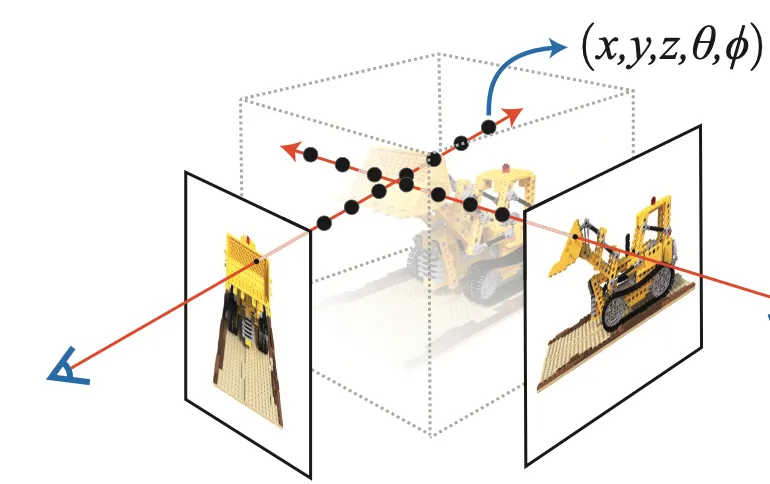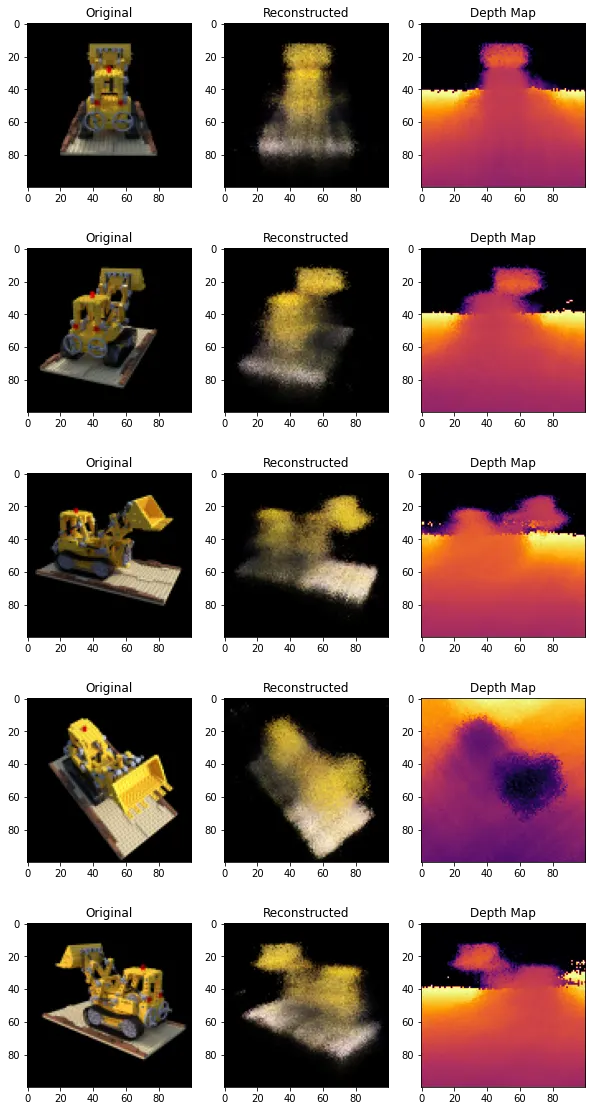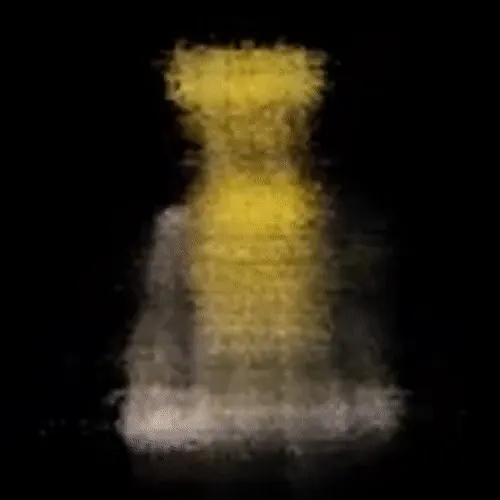Last modified: 2021/08/09
Description: Minimal implementation of volumetric rendering as shown in NeRF.
Introduction
In this example, we present a minimal implementation of the research paper NeRF: Representing Scenes as Neural Radiance Fields for View Synthesis by Ben Mildenhall et. al. The authors have proposed an ingenious way to synthesize novel views of a scene by modelling the volumetric scene function through a neural network.
To help you understand this intuitively, let's start with the following question: would it be possible to give to a neural network the position of a pixel in an image, and ask the network to predict the color at that position?
Figure 1: A neural network being given coordinates of an image
as input and asked to predict the color at the coordinates.
The neural network would hypothetically memorize (overfit on) the image. This means that our neural network would have encoded the entire image in its weights. We could query the neural network with each position, and it would eventually reconstruct the entire image.
Figure 2: The trained neural network recreates the image from scratch.
A question now arises, how do we extend this idea to learn a 3D volumetric scene? Implementing a similar process as above would require the knowledge of every voxel (volume pixel). Turns out, this is quite a challenging task to do.
The authors of the paper propose a minimal and elegant way to learn a 3D scene using a few images of the scene. They discard the use of voxels for training. The network learns to model the volumetric scene, thus generating novel views (images) of the 3D scene that the model was not shown at training time.
There are a few prerequisites one needs to understand to fully appreciate the process. We structure the example in such a way that you will have all the required knowledge before starting the implementation.
Setup
# Setting random seed to obtain reproducible results.
import tensorflow as tf
tf.random.set_seed(42)
import os
import glob
import imageio
import numpy as np
from tqdm import tqdm
from tensorflow import keras
from tensorflow.keras import layers
import matplotlib.pyplot as plt
# Initialize global variables.
AUTO = tf.data.AUTOTUNE
BATCH_SIZE = 5
NUM_SAMPLES = 32
POS_ENCODE_DIMS = 16
EPOCHS = 20
Plain Text
복사
Download and load the data
The npz data file contains images, camera poses, and a focal length. The images are taken from multiple camera angles as shown in Figure 3.
To understand camera poses in this context we have to first allow ourselves to think that a camera is a mapping between the real-world and the 2-D image.
Consider the following equation:
Where x is the 2-D image point, X is the 3-D world point and P is the camera-matrix. P is a 3 x 4 matrix that plays the crucial role of mapping the real world object onto an image plane.
The camera-matrix is an affine transform matrix that is concatenated with a 3 x 1 column [image height, image width, focal length] to produce the pose matrix. This matrix is of dimensions 3 x 5 where the first 3 x 3 block is in the camera’s point of view. The axes are [down, right, backwards] or [-y, x, z] where the camera is facing forwards -z.
Figure 5
# Download the data if it does not already exist.
file_name = "tiny_nerf_data.npz"
url = "https://people.eecs.berkeley.edu/~bmild/nerf/tiny_nerf_data.npz"
if not os.path.exists(file_name):
data = keras.utils.get_file(fname=file_name, origin=url)
data = np.load(data)
images = data["images"]
im_shape = images.shape
(num_images, H, W, _) = images.shape
(poses, focal) = (data["poses"], data["focal"])
# Plot a random image from the dataset for visualization.
plt.imshow(images[np.random.randint(low=0, high=num_images)])
plt.show()
Plain Text
복사
Downloading data from https://people.eecs.berkeley.edu/~bmild/nerf/tiny_nerf_data.npz
12730368/12727482 [==============================] - 0s 0us/step
Plain Text
복사
Data pipeline
Now that you've understood the notion of camera matrix and the mapping from a 3D scene to 2D images, let's talk about the inverse mapping, i.e. from 2D image to the 3D scene.
We'll need to talk about volumetric rendering with ray casting and tracing, which are common computer graphics techniques. This section will help you get to speed with these techniques.
Consider an image with N pixels. We shoot a ray through each pixel and sample some points on the ray. A ray is commonly parameterized by the equation r(t) = o + td where t is the parameter, o is the origin and d is the unit directional vector as shown in Figure 6.
Figure 6: r(t) = o + td where t is 3
In Figure 7, we consider a ray, and we sample some random points on the ray. These sample points each have a unique location (x, y, z) and the ray has a viewing angle (theta, phi). The viewing angle is particularly interesting as we can shoot a ray through a single pixel in a lot of different ways, each with a unique viewing angle. Another interesting thing to notice here is the noise that is added to the sampling process. We add a uniform noise to each sample so that the samples correspond to a continuous distribution. In Figure 7 the blue points are the evenly distributed samples and the white points (t1, t2, t3) are randomly placed between the samples.
Figure 7: Sampling the points from a ray.
Figure 8 showcases the entire sampling process in 3D, where you can see the rays coming out of the white image. This means that each pixel will have its corresponding rays and each ray will be sampled at distinct points.
Figure 8: Shooting rays from all the pixels of an image in 3-D
These sampled points act as the input to the NeRF model. The model is then asked to predict the RGB color and the volume density at that point.
def encode_position(x):
"""Encodes the position into its corresponding Fourier feature.
Args:
x: The input coordinate.
Returns:
Fourier features tensors of the position.
"""
positions = [x]
for i in range(POS_ENCODE_DIMS):
for fn in [tf.sin, tf.cos]:
positions.append(fn(2.0 ** i * x))
return tf.concat(positions, axis=-1)
def get_rays(height, width, focal, pose):
"""Computes origin point and direction vector of rays.
Args:
height: Height of the image.
width: Width of the image.
focal: The focal length between the images and the camera.
pose: The pose matrix of the camera.
Returns:
Tuple of origin point and direction vector for rays.
"""
# Build a meshgrid for the rays.
i, j = tf.meshgrid(
tf.range(width, dtype=tf.float32),
tf.range(height, dtype=tf.float32),
indexing="xy",
)
# Normalize the x axis coordinates.
transformed_i = (i - width * 0.5) / focal
# Normalize the y axis coordinates.
transformed_j = (j - height * 0.5) / focal
# Create the direction unit vectors.
directions = tf.stack([transformed_i, -transformed_j, -tf.ones_like(i)], axis=-1)
# Get the camera matrix.
camera_matrix = pose[:3, :3]
height_width_focal = pose[:3, -1]
# Get origins and directions for the rays.
transformed_dirs = directions[..., None, :]
camera_dirs = transformed_dirs * camera_matrix
ray_directions = tf.reduce_sum(camera_dirs, axis=-1)
ray_origins = tf.broadcast_to(height_width_focal, tf.shape(ray_directions))
# Return the origins and directions.
return (ray_origins, ray_directions)
def render_flat_rays(ray_origins, ray_directions, near, far, num_samples, rand=False):
"""Renders the rays and flattens it.
Args:
ray_origins: The origin points for rays.
ray_directions: The direction unit vectors for the rays.
near: The near bound of the volumetric scene.
far: The far bound of the volumetric scene.
num_samples: Number of sample points in a ray.
rand: Choice for randomising the sampling strategy.
Returns:
Tuple of flattened rays and sample points on each rays.
"""
# Compute 3D query points.
# Equation: r(t) = o+td -> Building the "t" here.
t_vals = tf.linspace(near, far, num_samples)
if rand:
# Inject uniform noise into sample space to make the sampling
# continuous.
shape = list(ray_origins.shape[:-1]) + [num_samples]
noise = tf.random.uniform(shape=shape) * (far - near) / num_samples
t_vals = t_vals + noise
# Equation: r(t) = o + td -> Building the "r" here.
rays = ray_origins[..., None, :] + (
ray_directions[..., None, :] * t_vals[..., None]
)
rays_flat = tf.reshape(rays, [-1, 3])
rays_flat = encode_position(rays_flat)
return (rays_flat, t_vals)
def map_fn(pose):
"""Maps individual pose to flattened rays and sample points.
Args:
pose: The pose matrix of the camera.
Returns:
Tuple of flattened rays and sample points corresponding to the
camera pose.
"""
(ray_origins, ray_directions) = get_rays(height=H, width=W, focal=focal, pose=pose)
(rays_flat, t_vals) = render_flat_rays(
ray_origins=ray_origins,
ray_directions=ray_directions,
near=2.0,
far=6.0,
num_samples=NUM_SAMPLES,
rand=True,
)
return (rays_flat, t_vals)
# Create the training split.
split_index = int(num_images * 0.8)
# Split the images into training and validation.
train_images = images[:split_index]
val_images = images[split_index:]
# Split the poses into training and validation.
train_poses = poses[:split_index]
val_poses = poses[split_index:]
# Make the training pipeline.
train_img_ds = tf.data.Dataset.from_tensor_slices(train_images)
train_pose_ds = tf.data.Dataset.from_tensor_slices(train_poses)
train_ray_ds = train_pose_ds.map(map_fn, num_parallel_calls=AUTO)
training_ds = tf.data.Dataset.zip((train_img_ds, train_ray_ds))
train_ds = (
training_ds.shuffle(BATCH_SIZE)
.batch(BATCH_SIZE, drop_remainder=True, num_parallel_calls=AUTO)
.prefetch(AUTO)
)
# Make the validation pipeline.
val_img_ds = tf.data.Dataset.from_tensor_slices(val_images)
val_pose_ds = tf.data.Dataset.from_tensor_slices(val_poses)
val_ray_ds = val_pose_ds.map(map_fn, num_parallel_calls=AUTO)
validation_ds = tf.data.Dataset.zip((val_img_ds, val_ray_ds))
val_ds = (
validation_ds.shuffle(BATCH_SIZE)
.batch(BATCH_SIZE, drop_remainder=True, num_parallel_calls=AUTO)
.prefetch(AUTO)
)
Plain Text
복사
NeRF model
The model is a multi-layer perceptron (MLP), with ReLU as its non-linearity.
An excerpt from the paper:
"We encourage the representation to be multiview-consistent by restricting the network to predict the volume density sigma as a function of only the location x, while allowing the RGB color c to be predicted as a function of both location and viewing direction. To accomplish this, the MLP first processes the input 3D coordinate x with 8 fully-connected layers (using ReLU activations and 256 channels per layer), and outputs sigma and a 256-dimensional feature vector. This feature vector is then concatenated with the camera ray's viewing direction and passed to one additional fully-connected layer (using a ReLU activation and 128 channels) that output the view-dependent RGB color."
Here we have gone for a minimal implementation and have used 64 Dense units instead of 256 as mentioned in the paper.
def get_nerf_model(num_layers, num_pos):
"""Generates the NeRF neural network.
Args:
num_layers: The number of MLP layers.
num_pos: The number of dimensions of positional encoding.
Returns:
The [`tf.keras`](https://www.tensorflow.org/api_docs/python/tf/keras) model.
"""
inputs = keras.Input(shape=(num_pos, 2 * 3 * POS_ENCODE_DIMS + 3))
x = inputs
for i in range(num_layers):
x = layers.Dense(units=64, activation="relu")(x)
if i % 4 == 0 and i > 0:
# Inject residual connection.
x = layers.concatenate([x, inputs], axis=-1)
outputs = layers.Dense(units=4)(x)
return keras.Model(inputs=inputs, outputs=outputs)
def render_rgb_depth(model, rays_flat, t_vals, rand=True, train=True):
"""Generates the RGB image and depth map from model prediction.
Args:
model: The MLP model that is trained to predict the rgb and
volume density of the volumetric scene.
rays_flat: The flattened rays that serve as the input to
the NeRF model.
t_vals: The sample points for the rays.
rand: Choice to randomise the sampling strategy.
train: Whether the model is in the training or testing phase.
Returns:
Tuple of rgb image and depth map.
"""
# Get the predictions from the nerf model and reshape it.
if train:
predictions = model(rays_flat)
else:
predictions = model.predict(rays_flat)
predictions = tf.reshape(predictions, shape=(BATCH_SIZE, H, W, NUM_SAMPLES, 4))
# Slice the predictions into rgb and sigma.
rgb = tf.sigmoid(predictions[..., :-1])
sigma_a = tf.nn.relu(predictions[..., -1])
# Get the distance of adjacent intervals.
delta = t_vals[..., 1:] - t_vals[..., :-1]
# delta shape = (num_samples)
if rand:
delta = tf.concat(
[delta, tf.broadcast_to([1e10], shape=(BATCH_SIZE, H, W, 1))], axis=-1
)
alpha = 1.0 - tf.exp(-sigma_a * delta)
else:
delta = tf.concat(
[delta, tf.broadcast_to([1e10], shape=(BATCH_SIZE, 1))], axis=-1
)
alpha = 1.0 - tf.exp(-sigma_a * delta[:, None, None, :])
# Get transmittance.
exp_term = 1.0 - alpha
epsilon = 1e-10
transmittance = tf.math.cumprod(exp_term + epsilon, axis=-1, exclusive=True)
weights = alpha * transmittance
rgb = tf.reduce_sum(weights[..., None] * rgb, axis=-2)
if rand:
depth_map = tf.reduce_sum(weights * t_vals, axis=-1)
else:
depth_map = tf.reduce_sum(weights * t_vals[:, None, None], axis=-1)
return (rgb, depth_map)
Plain Text
복사
Training
The training step is implemented as part of a custom keras.Model subclass so that we can make use of the model.fit functionality.
class NeRF(keras.Model):
def __init__(self, nerf_model):
super().__init__()
self.nerf_model = nerf_model
def compile(self, optimizer, loss_fn):
super().compile()
self.optimizer = optimizer
self.loss_fn = loss_fn
self.loss_tracker = keras.metrics.Mean(name="loss")
self.psnr_metric = keras.metrics.Mean(name="psnr")
def train_step(self, inputs):
# Get the images and the rays.
(images, rays) = inputs
(rays_flat, t_vals) = rays
with tf.GradientTape() as tape:
# Get the predictions from the model.
rgb, _ = render_rgb_depth(
model=self.nerf_model, rays_flat=rays_flat, t_vals=t_vals, rand=True
)
loss = self.loss_fn(images, rgb)
# Get the trainable variables.
trainable_variables = self.nerf_model.trainable_variables
# Get the gradeints of the trainiable variables with respect to the loss.
gradients = tape.gradient(loss, trainable_variables)
# Apply the grads and optimize the model.
self.optimizer.apply_gradients(zip(gradients, trainable_variables))
# Get the PSNR of the reconstructed images and the source images.
psnr = tf.image.psnr(images, rgb, max_val=1.0)
# Compute our own metrics
self.loss_tracker.update_state(loss)
self.psnr_metric.update_state(psnr)
return {"loss": self.loss_tracker.result(), "psnr": self.psnr_metric.result()}
def test_step(self, inputs):
# Get the images and the rays.
(images, rays) = inputs
(rays_flat, t_vals) = rays
# Get the predictions from the model.
rgb, _ = render_rgb_depth(
model=self.nerf_model, rays_flat=rays_flat, t_vals=t_vals, rand=True
)
loss = self.loss_fn(images, rgb)
# Get the PSNR of the reconstructed images and the source images.
psnr = tf.image.psnr(images, rgb, max_val=1.0)
# Compute our own metrics
self.loss_tracker.update_state(loss)
self.psnr_metric.update_state(psnr)
return {"loss": self.loss_tracker.result(), "psnr": self.psnr_metric.result()}
@property
def metrics(self):
return [self.loss_tracker, self.psnr_metric]
test_imgs, test_rays = next(iter(train_ds))
test_rays_flat, test_t_vals = test_rays
loss_list = []
class TrainMonitor(keras.callbacks.Callback):
def on_epoch_end(self, epoch, logs=None):
loss = logs["loss"]
loss_list.append(loss)
test_recons_images, depth_maps = render_rgb_depth(
model=self.model.nerf_model,
rays_flat=test_rays_flat,
t_vals=test_t_vals,
rand=True,
train=False,
)
# Plot the rgb, depth and the loss plot.
fig, ax = plt.subplots(nrows=1, ncols=3, figsize=(20, 5))
ax[0].imshow(keras.preprocessing.image.array_to_img(test_recons_images[0]))
ax[0].set_title(f"Predicted Image: {epoch:03d}")
ax[1].imshow(keras.preprocessing.image.array_to_img(depth_maps[0, ..., None]))
ax[1].set_title(f"Depth Map: {epoch:03d}")
ax[2].plot(loss_list)
ax[2].set_xticks(np.arange(0, EPOCHS + 1, 5.0))
ax[2].set_title(f"Loss Plot: {epoch:03d}")
fig.savefig(f"images/{epoch:03d}.png")
plt.show()
plt.close()
num_pos = H * W * NUM_SAMPLES
nerf_model = get_nerf_model(num_layers=8, num_pos=num_pos)
model = NeRF(nerf_model)
model.compile(
optimizer=keras.optimizers.Adam(), loss_fn=keras.losses.MeanSquaredError()
)
# Create a directory to save the images during training.
if not os.path.exists("images"):
os.makedirs("images")
model.fit(
train_ds,
validation_data=val_ds,
batch_size=BATCH_SIZE,
epochs=EPOCHS,
callbacks=[TrainMonitor()],
steps_per_epoch=split_index // BATCH_SIZE,
)
def create_gif(path_to_images, name_gif):
filenames = glob.glob(path_to_images)
filenames = sorted(filenames)
images = []
for filename in tqdm(filenames):
images.append(imageio.imread(filename))
kargs = {"duration": 0.25}
imageio.mimsave(name_gif, images, "GIF", **kargs)
create_gif("images/*.png", "training.gif")
Plain Text
복사
Epoch 1/20
16/16 [==============================] - 15s 753ms/step - loss: 0.1134 - psnr: 9.7278 - val_loss: 0.0683 - val_psnr: 12.0722
Plain Text
복사
Epoch 2/20
16/16 [==============================] - 13s 752ms/step - loss: 0.0648 - psnr: 12.4200 - val_loss: 0.0664 - val_psnr: 12.1765
Plain Text
복사
Epoch 3/20
16/16 [==============================] - 13s 746ms/step - loss: 0.0607 - psnr: 12.5281 - val_loss: 0.0673 - val_psnr: 12.0121
Plain Text
복사
Epoch 4/20
16/16 [==============================] - 13s 758ms/step - loss: 0.0595 - psnr: 12.7050 - val_loss: 0.0646 - val_psnr: 12.2768
Plain Text
복사
Epoch 5/20
16/16 [==============================] - 13s 755ms/step - loss: 0.0583 - psnr: 12.7522 - val_loss: 0.0613 - val_psnr: 12.5351
Plain Text
복사
Epoch 6/20
16/16 [==============================] - 13s 749ms/step - loss: 0.0545 - psnr: 13.0654 - val_loss: 0.0553 - val_psnr: 12.9512
Plain Text
복사
Epoch 7/20
16/16 [==============================] - 13s 744ms/step - loss: 0.0480 - psnr: 13.6313 - val_loss: 0.0444 - val_psnr: 13.7838
Plain Text
복사
Epoch 8/20
16/16 [==============================] - 13s 763ms/step - loss: 0.0359 - psnr: 14.8570 - val_loss: 0.0342 - val_psnr: 14.8823
Plain Text
복사
Epoch 9/20
16/16 [==============================] - 13s 758ms/step - loss: 0.0299 - psnr: 15.5374 - val_loss: 0.0287 - val_psnr: 15.6171
Plain Text
복사
Epoch 10/20
16/16 [==============================] - 13s 779ms/step - loss: 0.0273 - psnr: 15.9051 - val_loss: 0.0266 - val_psnr: 15.9319
Plain Text
복사
Epoch 11/20
16/16 [==============================] - 13s 736ms/step - loss: 0.0255 - psnr: 16.1422 - val_loss: 0.0250 - val_psnr: 16.1568
Plain Text
복사
Epoch 12/20
16/16 [==============================] - 13s 746ms/step - loss: 0.0236 - psnr: 16.5074 - val_loss: 0.0233 - val_psnr: 16.4793
Plain Text
복사
Epoch 13/20
16/16 [==============================] - 13s 755ms/step - loss: 0.0217 - psnr: 16.8391 - val_loss: 0.0210 - val_psnr: 16.8950
Plain Text
복사
Epoch 14/20
16/16 [==============================] - 13s 741ms/step - loss: 0.0197 - psnr: 17.2245 - val_loss: 0.0187 - val_psnr: 17.3766
Plain Text
복사
Epoch 15/20
16/16 [==============================] - 13s 739ms/step - loss: 0.0179 - psnr: 17.6246 - val_loss: 0.0179 - val_psnr: 17.5445
Plain Text
복사
Epoch 16/20
16/16 [==============================] - 13s 735ms/step - loss: 0.0175 - psnr: 17.6998 - val_loss: 0.0180 - val_psnr: 17.5154
Plain Text
복사
Epoch 17/20
16/16 [==============================] - 13s 741ms/step - loss: 0.0167 - psnr: 17.9393 - val_loss: 0.0156 - val_psnr: 18.1784
Plain Text
복사
Epoch 18/20
16/16 [==============================] - 13s 750ms/step - loss: 0.0150 - psnr: 18.3875 - val_loss: 0.0151 - val_psnr: 18.2811
Plain Text
복사
Epoch 19/20
16/16 [==============================] - 13s 755ms/step - loss: 0.0141 - psnr: 18.6476 - val_loss: 0.0139 - val_psnr: 18.6216
Plain Text
복사
Epoch 20/20
16/16 [==============================] - 14s 777ms/step - loss: 0.0139 - psnr: 18.7131 - val_loss: 0.0137 - val_psnr: 18.7259
Plain Text
복사
100%|██████████| 20/20 [00:00<00:00, 57.59it/s]
Plain Text
복사
Visualize the training step
Here we see the training step. With the decreasing loss, the rendered image and the depth maps are getting better. In your local system, you will see the training.gif file generated.
Inference
In this section, we ask the model to build novel views of the scene. The model was given 106 views of the scene in the training step. The collections of training images cannot contain each and every angle of the scene. A trained model can represent the entire 3-D scene with a sparse set of training images.
Here we provide different poses to the model and ask for it to give us the 2-D image corresponding to that camera view. If we infer the model for all the 360-degree views, it should provide an overview of the entire scenery from all around.
# Get the trained NeRF model and infer.
nerf_model = model.nerf_model
test_recons_images, depth_maps = render_rgb_depth(
model=nerf_model,
rays_flat=test_rays_flat,
t_vals=test_t_vals,
rand=True,
train=False,
)
# Create subplots.
fig, axes = plt.subplots(nrows=5, ncols=3, figsize=(10, 20))
for ax, ori_img, recons_img, depth_map in zip(
axes, test_imgs, test_recons_images, depth_maps
):
ax[0].imshow(keras.preprocessing.image.array_to_img(ori_img))
ax[0].set_title("Original")
ax[1].imshow(keras.preprocessing.image.array_to_img(recons_img))
ax[1].set_title("Reconstructed")
ax[2].imshow(
keras.preprocessing.image.array_to_img(depth_map[..., None]), cmap="inferno"
)
ax[2].set_title("Depth Map")
Plain Text
복사
Render 3D Scene
Here we will synthesize novel 3D views and stitch all of them together to render a video encompassing the 360-degree view.
def get_translation_t(t):
"""Get the translation matrix for movement in t."""
matrix = [
[1, 0, 0, 0],
[0, 1, 0, 0],
[0, 0, 1, t],
[0, 0, 0, 1],
]
return tf.convert_to_tensor(matrix, dtype=tf.float32)
def get_rotation_phi(phi):
"""Get the rotation matrix for movement in phi."""
matrix = [
[1, 0, 0, 0],
[0, tf.cos(phi), -tf.sin(phi), 0],
[0, tf.sin(phi), tf.cos(phi), 0],
[0, 0, 0, 1],
]
return tf.convert_to_tensor(matrix, dtype=tf.float32)
def get_rotation_theta(theta):
"""Get the rotation matrix for movement in theta."""
matrix = [
[tf.cos(theta), 0, -tf.sin(theta), 0],
[0, 1, 0, 0],
[tf.sin(theta), 0, tf.cos(theta), 0],
[0, 0, 0, 1],
]
return tf.convert_to_tensor(matrix, dtype=tf.float32)
def pose_spherical(theta, phi, t):
"""
Get the camera to world matrix for the corresponding theta, phi
and t.
"""
c2w = get_translation_t(t)
c2w = get_rotation_phi(phi / 180.0 * np.pi) @ c2w
c2w = get_rotation_theta(theta / 180.0 * np.pi) @ c2w
c2w = np.array([[-1, 0, 0, 0], [0, 0, 1, 0], [0, 1, 0, 0], [0, 0, 0, 1]]) @ c2w
return c2w
rgb_frames = []
batch_flat = []
batch_t = []
# Iterate over different theta value and generate scenes.
for index, theta in tqdm(enumerate(np.linspace(0.0, 360.0, 120, endpoint=False))):
# Get the camera to world matrix.
c2w = pose_spherical(theta, -30.0, 4.0)
#
ray_oris, ray_dirs = get_rays(H, W, focal, c2w)
rays_flat, t_vals = render_flat_rays(
ray_oris, ray_dirs, near=2.0, far=6.0, num_samples=NUM_SAMPLES, rand=False
)
if index % BATCH_SIZE == 0 and index > 0:
batched_flat = tf.stack(batch_flat, axis=0)
batch_flat = [rays_flat]
batched_t = tf.stack(batch_t, axis=0)
batch_t = [t_vals]
rgb, _ = render_rgb_depth(
nerf_model, batched_flat, batched_t, rand=False, train=False
)
temp_rgb = [np.clip(255 * img, 0.0, 255.0).astype(np.uint8) for img in rgb]
rgb_frames = rgb_frames + temp_rgb
else:
batch_flat.append(rays_flat)
batch_t.append(t_vals)
rgb_video = "rgb_video.mp4"
imageio.mimwrite(rgb_video, rgb_frames, fps=30, quality=7, macro_block_size=None)
Plain Text
복사
120it [00:12, 9.24it/s]
Plain Text
복사
Visualize the video
Here we can see the rendered 360 degree view of the scene. The model has successfully learned the entire volumetric space through the sparse set of images in only 20 epochs. You can view the rendered video saved locally, named rgb_video.mp4.
Conclusion
We have produced a minimal implementation of NeRF to provide an intuition of its core ideas and methodology. This method has been used in various other works in the computer graphics space.
We would like to encourage our readers to use this code as an example and play with the hyperparameters and visualize the outputs. Below we have also provided the outputs of the model trained for more epochs.
Epochs
100
200
Reference
•
NeRF repository: The official repository for NeRF.
•
NeRF paper: The paper on NeRF.
•
Manim Repository: We have used manim to build all the animations.
•
Mathworks: Mathworks for the camera calibration article.
•
Mathew's video: A great video on NeRF.
